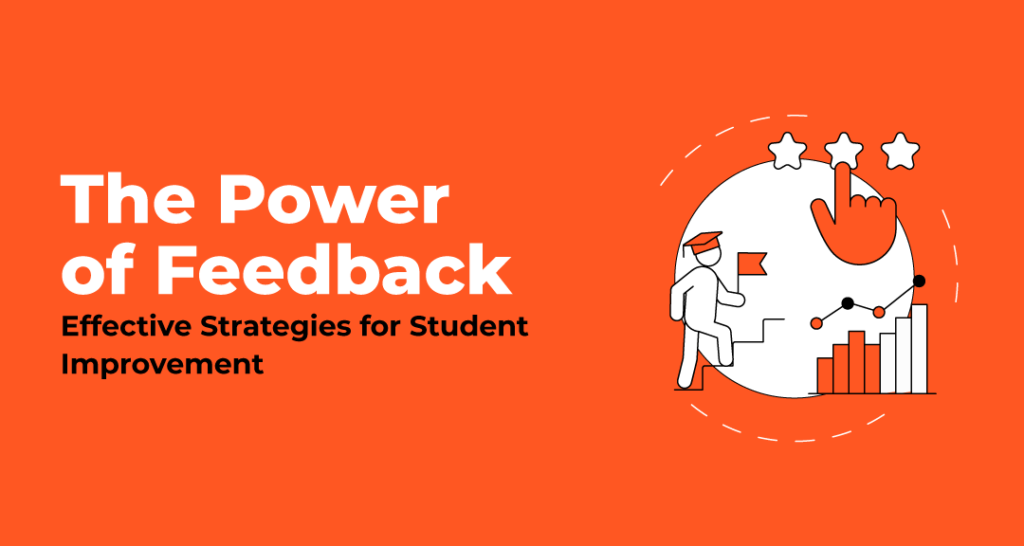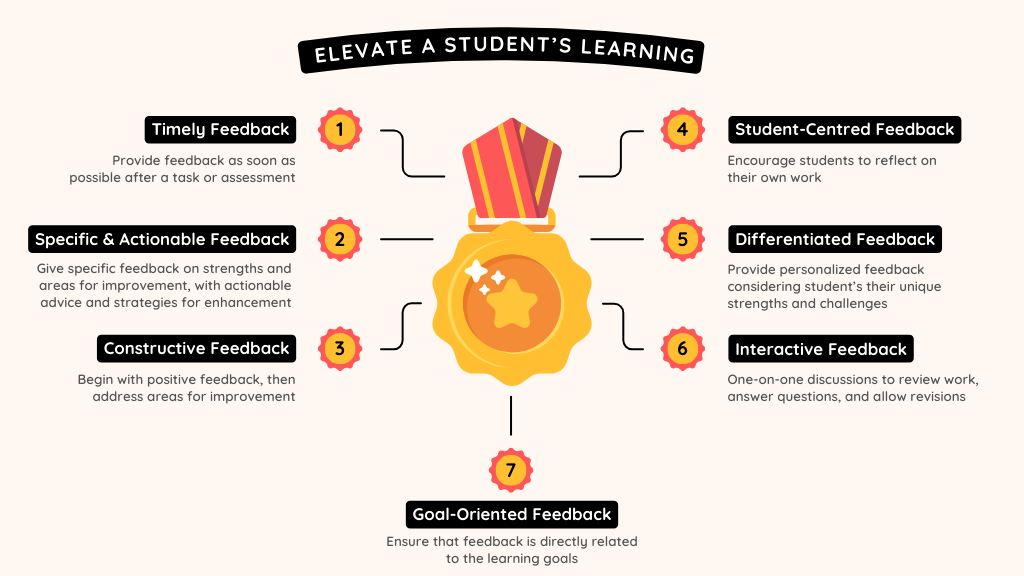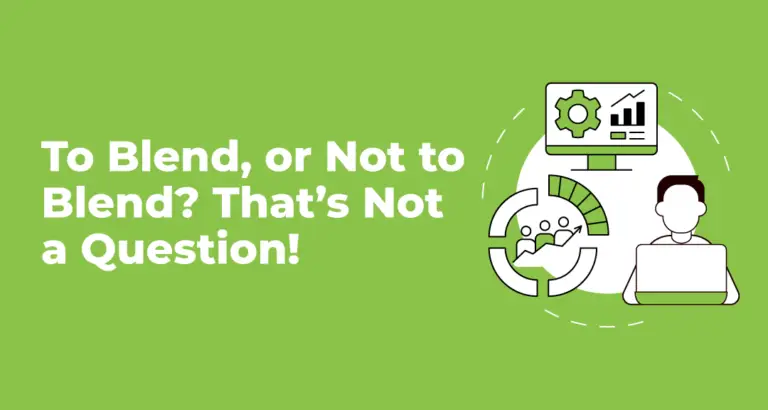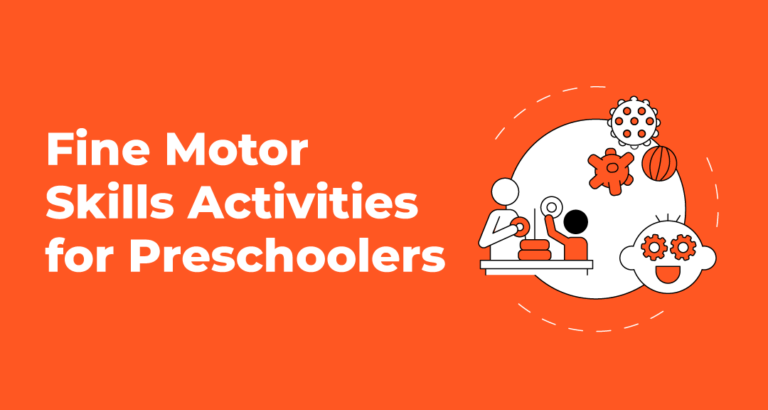The Power of Feedback: Effective Strategies for Student Improvement
- School Leaders, Teaching
- August 31, 2024
- Viva VOLT

Picture a young artist standing before a blank canvas, holding a paintbrush in one hand, brimming with potential but unsure where to begin. Now, imagine a master painter by her side, gently guiding her hand, pointing out the interplay of light and shadow, and sharing secrets of colour and composition. This is the essence of powerful feedback in education – not just a critique, but a transformative interaction between mentor and student, turning raw talent into mastery.
Welcome to the feedback revolution where learning isn’t just about finding the right answers, but also about asking the questions that change everything. Feedback is the spotlight in a child’s overall learning experience that illuminates the path for a novice to be transformed into a virtuoso. At times, this secret ingredient turns the mundane learning into an extraordinary moment, the confused learner into a confident individual, and the discouraged one into an inspired soul.
But in every scenario the twist is always in the performance quotient. Every student can be both a star and a critic. An effective feedback from teachers and parents is not just instrumental in guiding the right path, but it also turns
- every “wrong” answer into a treasure map;
- every struggle into a thrilling mystery to be resolved; and
- every success into a launch-pad raising the bar for its attainment.
The magic of effective feedback is much beyond our imagination. It’s not just about correcting errors, but also about igniting curiosity, fostering resilience, and sculpting minds that don’t merely absorb knowledge, but create it.
So, are you ready to embark on a journey through the looking glass of learning? Do you want to discover how a well-timed word, a thoughtful question, or an encouraging nod can spark revolutions in young minds? Buckle up then, because we’re about to explore the electrifying world of feedback , the one where every conversation is a potential eureka moment, and every classroom a laboratory of endless possibilities.
How ineffective or vague feedback can hinder student learning?
Ineffective or vague feedback can be a significant roadblock to a student’s learning journey, often doing more harm than good. Let’s explore how this well-intentioned yet misguided approach can actually hinder a student’s progress.
• Confusion and Frustration: Vague comments like ’Good job‘ or ’Needs improvement‘ leave students in the dark. Without specifics, they’re left guessing what exactly was good or what needs to be improved, leading to frustration and a sense of helplessness.
• Missed Learning Opportunities: When feedback lacks detail, students miss out on valuable chances to understand their mistakes and learn from them. It’s like giving someone a map with no landmarks; they know they need to go somewhere, but have no idea as to how they can get there.
• Demotivation: Consistently receiving vague or abstruse feedback can be demotivating. Students may feel that their efforts are not being recognized or that their teacher doesn’t care enough to provide thoughtful guidance.
• Reinforcement of Incorrect Notions and Practices: Without clear direction, students might continue committing the same mistakes, reinforcing misleading practices or adhering to misconceptions and counterproductive notions. It’s akin to repeatedly taking a wrong turn because no one pointed out the correct route.
• Stunted Self-Reflection Skills: Vague feedback doesn’t encourage students to think critically about their work. It fails to provide the prompts needed for meaningful self-reflection and improvement.
• Anxiety and Insecurity: When students can’t decipher what their teacher wants or means, it can lead to anxiety about future assignments. They might second-guess themselves, unsure of what constitutes good work.
• Obstacle to the Development of a Growth-oriented Mindset: Ineffective feedback often focuses on the person rather than the process (e.g., ’You’re smart‘ instead of ’Your strategy was effective‘). This can hinder the development of a growth-oriented mindset, which is crucial for long-term learning.
• Misalignment with Learning Goals: Vague feedback often fails to connect the student’s work with specific learning objectives, leaving them at sea about their progress towards academic goals.
Ineffective or vague feedback doesn’t just miss the mark; it can actually set students back, leaving them confused and demotivated. Without a clear guidance, students struggle to improve, missing out on crucial learning opportunities. Effective feedback is thus a powerful catalyst for growth without which a child’s progress is stalled as the core potential is left untapped.
Transformative feedback strategies to elevate a student’s learning: Teacher’s guide

Transformative feedback strategies can elevate a student’s learning by making each interaction a powerful learning moment. A positive feedback becomes a tool that not only addresses gaps but also inspires growth, builds confidence, and fosters a deeper understanding of the material.
Are you ready to take your feedback to the next level? Here are proven feedback strategies that can help improve a student’s performance and ensure better outcomes.
1. Timely Feedback
Providing feedback as soon as possible after a task or assessment ensures that students can make connections between their actions and the feedback, making it more impactful. Use of formative assessments leads to regular and low-stake feedback helping the teachers guide a student throughout the course of learning, rather than waiting until the end.
2. Specific and Actionable Feedback
Instead of generic praise or criticism, teachers should provide specific comments that highlight the positive aspects of a student’s performance , as well as the areas where improvement is required. Additionally, teachers can offer actionable advice on how students can improve, touching upon the productive strategies to be employed or specific areas to focus on.
3. Constructive Feedback
Start with what the positive side of a student’s performance before moving on to areas that need improvement. This builds confidence and encourages a growth-oriented mindset. Emphasize effort and strategies rather than innate ability, helping students understand that their skills can improve with practice.
4. Student-Centred Feedback
Encourage students to reflect on their own work before coming up with any feedback. This promotes metacognition and helps students take ownership of their learning. Facilitate structured-peer review sessions where students can give feedback and receive the same from their classmates, fostering collaboration and critical thinking.
5. Differentiated Feedback
Provide personalized feedback focused on a student’s current level of understanding, taking into account their unique strengths and challenges. Teachers can rely on different methods of feedback, such as written comments, verbal discussions, or digital tools, to cater to different learning styles.
6. Interactive Feedback
Engage in one-on-one conversations with students to discuss their work and feedback, allowing them to ask questions and clarify doubts. It creates opportunities for students to respond to feedback, make revisions and resubmit their work, reinforcing the learning process.
7. Goal-Oriented Feedback
Ensure that feedback is directly related to the learning goals and objectives of the lesson or course. It helps students set specific, measurable goals based on the feedback they receive, guiding their progress toward improvement.
Creating a strong feedback culture in your classroom can transform how students engage with their learning and with each other. Here are quick tips for teachers to integrate healthy and meaningful feedback inside the classroom and foster a positively harmonious culture.
1. Model Constructive Feedback
- Lead by Example: Regularly provide students with constructive, practicable feedback. Show them how to give feedback that is specific, supportive, and focused on improvement.
- Encourage Self-Reflection: Reflect on your teaching practices openly with your students, demonstrating that everyone can benefit from feedback.
2. Set Clear Expectations
- Define What Feedback Is: Make sure students understand that feedback is a tool for growth, not criticism. Establish that it’s a regular, integral part of learning.
- Create a Safe Environment: Create a classroom atmosphere in which students feel comfortable giving and receiving feedback without fear of judgment.
3. Incorporate Peer Feedback
- Teach Peer Review Skills: Provide students with guidelines on how to give constructive feedback to their peers, emphasizing the importance of being specific, respectful and helpful.
- Regular Peer Feedback Sessions: Integrate peer feedback activities into your lessons, allowing students to practise giving and receiving feedback regularly.
4. Encourage Self-Assessment
- Self-Evaluation Tools: Provide students with rubrics or checklists to evaluate their own work before receiving feedback from others. This encourages them to reflect on their learning and identify areas for improvement.
- Set Personal Goals: Encourage students to set learning goals based on their self-assessment and the feedback they receive.
5. Celebrate Growth and Progress
- Highlight Improvements: Regularly acknowledge and appreciate the progress students make based on feedback. This reinforces the value of feedback and motivates students to continue striving for improvement.
- Feedback on Feedback: Encourage students to reflect on how feedback has helped them grow, reinforcing the positive impact of a feedback culture.
6. Foster Open Communication
- Two-Way Feedback: Invite students to provide feedback on the classroom environment and teaching methods. This not only empowers them but also helps you adapt to their needs.
- Feedback Discussions: Hold regular class discussions about the feedback process, allowing students to share their thoughts and experiences openly.
By embedding these strategies into your classroom routine, you can create a thriving feedback culture that empowers students to take ownership of their learning and improve continuously.
Elevate Your Classroom with Seamless Feedback Integration
Integrating effective feedback into your classroom is key to enhancing the learning experience, and Viva Online Learning Technologies makes it effortless. We act as an effective platform for imparting education where teachers and parents can get involved in blended form with good illustrative videos and interesting activities. By leveraging Viva’s resources, they can foster a growth-oriented mindset, and consistently engage students in their learning journey. Don’t miss out on the opportunity to transform your teaching and boost learning outcomes.
Start using Viva Online Learning Technologies today and you will see how big a difference it makes to your classroom making it more dynamic and the process of learning more effective!



